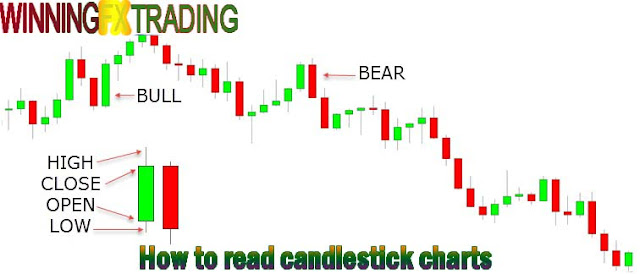The popularity of candlestick charts to trade exploded when they arrived at the scene and for a very good reason: the amount of information you can get from a casual glance at the candlestick chart makes graphic reading much easier.
Each candle contains 2 parts, regardless of the time it is operating:
the body which is the widest part of the candelabrum
shadows or streaks that appear at each end (sometimes) candle.
These parts represent candle for each candle:
the opening price
the closing price
the highest price
the lowest price
It is a graphical representation of price fluctuations for any instrument in any time frame.
Each candle will show the relationship between these four prices and easier to read which side, bulls or bears took control of the trading session. There are some operators who ignore the ups and downs of the sessions and only use the bodies of the candles, opening and closing, to make trading decisions.
New sails equivalent to new information
The construction of each candle on your table shows the opening price and that will occur in the upper or lower body.
The highs and lows of the session will be displayed according to the distance traveled by the upper and lower wicks. There will be times when you will not show wicks and that is called "candelabra (candle) shaving".
The closing price is the last element to draw and will be displayed in the body of the candlestick (candle).
In general, if the closing is lower than the open, the candlestick (candle) will close in red which means that the bears were in charge of the session covered the candlestick (candle)
If the candle closes in green, the close is higher than the opening price.
During the formation of a candelabrum (candle), you will often see the color change red-green-red-green, while the battle between buyers and sellers develops. The only part of candlestick chart formation that does not change is the opening price. Everyone else, change ups and downs and finally end at a closing price that will remain. The highest price and the lowest price reached during that session will be drawn through the wicks.
The color of the candlestick (candle) shows the direction
When the candlestick (candle) is closed, operators can immediately see which direction price, high or low, won the battle of imbalance for that time period.
Green closures indicate a strong intent to purchase at that time frame
Closures red indicate a strong intent to sell
You can also determine a glance how much the price moved in relation to the candles that preceded the most recent. For a more objective view, the difference between high and low of the candlestick (candle) will determine the actual price range for that period.
Knowing the range can help determine whether an operator is building up momentum in the instrument that is being marketed.
Features candelabra (candle)
You can determine through its color graphics platform candelabra (candle) Bullish and candelabra (candle) bears. You can also make holes chandeliers instead of filled. Some traders believe that the color is a distraction, while others prefer easily see the colorful candles.
There are cosmetics and regardless of how you see your graphic changes, the information is exactly the same.
Candlesticks (sailing) popular trade
While I have not seen any statistical validity to the use of individual stanchions for trading decisions, these are some of the most popular used by traders.
5 main patterns bullish candles
The hammer
The perforation line
Bullish Engulfing The
Morning Star
The Bullish Doji Star
5 main bearish candle patterns
Inverted hammer or some call a shooting star (although looks like one ...)
That man pendant.
Dark Cloud Cover
bearish Harami
Bearish engulfing pattern
4 formations neutral candles
trompos
the doji
double doji
the Harami pattern
4 reverse stanchions
Long-legged doji
the dragonfly doji
Gravestone Doji
stars












0 Comments:
Post a Comment